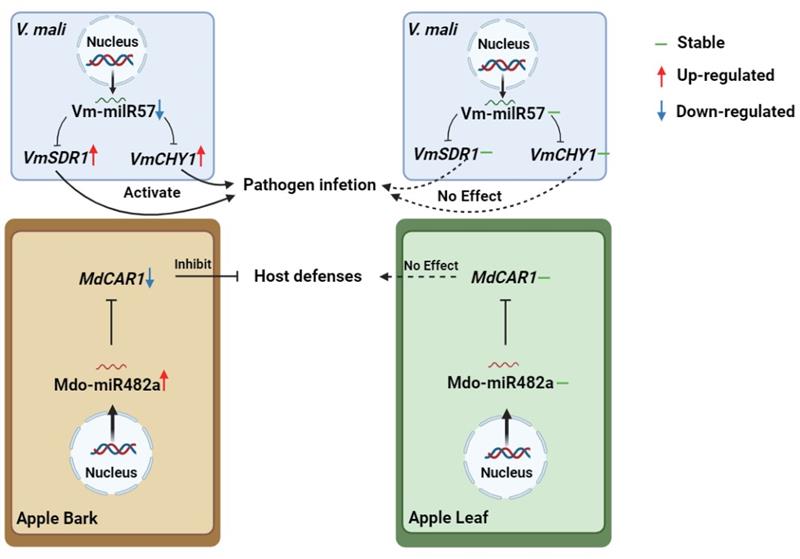Recently, the research group led by Prof. Huang Lili from our college published a research paper titled "Adaptive regulation of miRNAs/milRNAs in tissue specific interaction between apple and Valsa mali" in the journal Horticulture Research. The study constructed differential expression profiles of apple miRNAs and Valsa mali milRNAs in the interaction between different tissues of apple and the pathogen, and identified key tissue infection-specific expression of host miRNAs and pathogen milRNAs. Ph.D student Gao Chengyu from our college is the first author of this paper, with Prof. Huang Lili and Prof. Feng Hao as the corresponding authors.
During the interaction between plants and pathogens, pathogens often selectively infect and destroy specific tissues of plants. “miRNAs/milRNAs” are a class of regulatory factors that inhibit gene expression at the post-transcriptional level and play an important role in the interaction between plants and pathogens. However, it has not been reported whether miRNAs/milRNAs are involved in the tissue-specific regulation of pathogens and plants.
The study established a library of miRNAs/milRNAs involved in the interaction between V. mali and different tissues of apple, and found that miRNAs/milRNAs exhibited different expression characteristics in different interaction systems. The expression profiles of miRNAs/milRNAs involved in tissue-specific regulation were mapped, and their potential regulatory networks were explored. On this basis, it was found that apple Mdo-miR482a specifically upregulated its expression in response to V. mali infection in bark tissue, and played an anti-disease function in the process of apple responding to V. mali infection. Further analysis found that its target was an NLR gene related to disease resistance in apple. At the same time, it was found that Vm-milR57 of V. mali downregulated its expression during the infection of bark tissue, which can target and inhibit two genes positively related to pathogenicity to enhance the pathogenicity of V. mali. It can be seen that Mdo-miR482a and Vm-milR57 exhibit tissue infection-specific regulation in the interaction between V. mali and apple bark or leaves. This is the first study to reveal the tissue-specific regulation of apple miRNAs and Valsa mali milRNAs in the interaction between pathogens and host tissues, providing a new perspective for understanding the interaction and adaptive regulation mechanisms between pathogens and specific tissues of plants.

The experimental platform, State Key laboratory for Crop Stress Resistance and High-Efficiency Production, provided technical support for this study. And this study was funded by the National Natural Science Foundation of China (U1903206, 32172375) and the Major Science and Technology Project of Shaanxi Province (2020zdzx03-03-01).
Original link: https://doi.org/10.1093/hr/uhae094